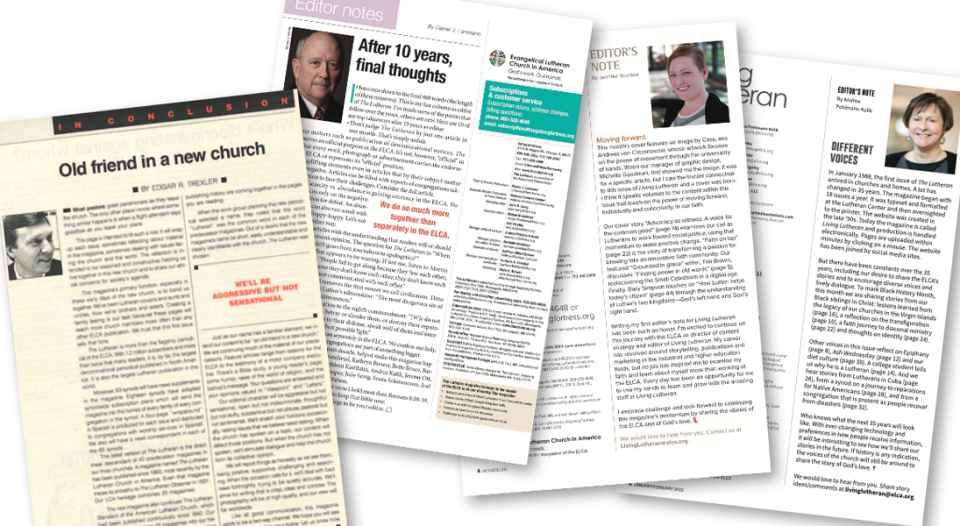Martin Luther’s reforming ideas spread like wildfire in the 16th century because the recently invented printing press enabled mass distribution of his treatises and pamphlets. Since then Lutherans have been informed and guided by the printed word, including generations of magazines bearing the Lutheran name on their covers.
Technology has again changed the way people receive information. Websites, podcasts, blogs, social media—the options are many and growing. At the same time, costs to produce print publications have continued to increase. These factors have affected this church’s flagship publication financially, and after this issue only one more Living Lutheran print edition will fall into our mailboxes.
Just as Luther embraced new technology, the magazine is adapting to new ways of communicating the ELCA’s message. The format will change, but the storytelling will continue with an enhanced online presence at livinglutheran.org beginning in January 2024.
As this historic change is upon us, a retrospective assessment is in order. Since American Lutheran publications first began in 1831 with the first issue of the Lutheran Observer, what has been their impact in the life of the church? More specifically, what role has Living Lutheran and its predecessor, the Lutheran, played in the ELCA?
Several individuals intimately involved with the magazine and others with insider views on church journalism shared their perspectives.
Pioneering editor’s reflections
Now In his mid-80s, Edgar Trexler is regarded by many as the dean of American Lutheran church journalists. For a third of a century prior to his retirement in 1999, Trexler’s name appeared on the masthead of 660 issues of the Lutheran. When the ELCA was formed in 1988, the editor of the former Lutheran Church in America’s publication was chosen to head a magazine by the same name for the new denomination.
Reflecting on the magazine’s approach under his leadership, Trexler said the goal was “sharing ideas and points of view, bringing out the best in the church and its people.” As the ELCA faced one after another challenging issue, Trexler saw the Lutheran’s role as helping “the church make good decisions.”
Each issue included stories about congregations that could be replicated elsewhere, profiles of individuals doing inspiring work, a feature about a global partner and news from the broader ecumenical scene.
Trexler saw the Lutheran’s role as helping “the church make good decisions.”
Trexler frequently reminded his colleagues that “The Lutheran is recording the contemporary history of the church.”
Many remember his editorials that included one-word descriptors of ELCA churchwide assemblies. Asked to do the same for the legacy of Living Lutheran and its predecessors, Trexler described their enduring impact as “influential.”
“I think we made a difference,” he concluded.
Changes in editors, name and focus
The appointment of Daniel Lehmann as editor in 2006 marked a change seen more broadly in other church leadership positions. Lehmann, the ELCA’s first lay editor, brought to bear extensive secular journalistic experience, helpful at the time our denomination was seeking to become a more “public church.”
Lehmann recalled how the magazine continued to blend inspirational stories with news of “what was happening in the denomination.” The latter were not always well-received, including stories that simply reported the facts about ELCA membership loss, aging clergy roster trends and declining seminary enrollments, he added.
In response to a challenging letter, which suggested the magazine needed more robust theological content, Lehmann initiated the “Deeper understandings” column. Articles by seminary and college professors treating a broad variety of issues became a hit with many readers and will continue online going forward.
After a decade in the magazine’s top spot, Lehmann reflected in a final editorial on his gratitude for stories “filled with reports of congregations taking positive action to face their challenges” (The Lutheran, January 2016).
“The story will continue,” said Kulik. “We’ll try to keep everybody connected.”
Lehmann’s successors at the editorial helm have all been women. Under their leadership, the renamed Living Lutheran shifted to be even more congregation-focused, as called for by many readers in focus groups and surveys. News about churchwide, synodical and institutional life was balanced with more extensive articles on how congregations and members carry out faithful ministries in diverse contexts.
Thinking back on her years with the magazine (from 2016 to 2020), Jennifer Younker is grateful for its “impact of creating connections, a community.” Helping readers grasp that “we’re all united through our faith and we’re working throughout the country and globally,” brought Younker joy, she said. She recalls “little moments” like a story about an ELCA member who started the nationwide Little Free Pantry movement.
Current editor Andrea Pohlmann Kulik will be at the helm as the final print edition is put to bed. Then her attention will shift to telling the church’s stories in new ways. As she reflected on changes in communications, Kulik pointed to a much more competitive atmosphere. People used to decide “among a few magazines on the coffee table,” she said, whereas now hundreds of emails, websites, podcasts and social media sources demand our attention.
Kulik shares the sadness conveyed by many readers who emailed and called as they contemplated the loss of the print magazine. But she is also convinced that online delivery will allow the magazine to provide more news in a timely fashion and increase the number of articles and voices that can be offered.
“The story will continue,” she said. “We’ll try to keep everybody connected.”
Other perspectives
Sharing Trexler’s understanding that journalists write the first rough draft of history, Maria Erling noted the magazine’s value as a resource. The professor of modern church history and global mission at United Lutheran Seminary relies heavily upon Lutheran publications in teaching American church history. She sends students in search of magazines preserved in their school’s library and archives, which will have only digital records of most future historical events.
John Spangler of Gettysburg, Pa., a longtime church communications professional, served for nearly a decade on the advisory committee the magazine had at the time. During his days as a parish pastor and synod communicator, he found the magazine was an important resource in helping members become inspired about the wider church’s national and global impact.
“It’s our Lutheran tradition to be honest,” Shafer said. “We’ve never been a denomination that hides the truth.”
Many congregations, he remembers, purchased the every-home plan, which ensured each household would receive news and stories about our denomination.
Eric Shafer, former director of the ELCA Department for Communication, had an insider’s view of the magazine as a synod correspondent and contributing editor early in his career. Back in 1988 when the magazine arrived 18 times a year in most members’ homes, he said, the Lutheran “was a calling card” that reminded folks of their denomination and “helped knit the church together.”
All rostered ministers, he said, were given a free copy to guarantee that they would receive accurate information on priorities and events occurring in the ELCA. He also cited the magazine’s coverage of churchwide assemblies and Youth Gatherings in keeping members informed of these major events.
The magazine has been a vehicle to tell the truth, Shafer added. “It’s our Lutheran tradition to be honest,” he said. “We’ve never been a denomination that hides the truth.”
Into the future
While many in our church will greet the digital future with enthusiasm and excitement, leadership is aware that there is sadness at losing the print magazine.
A recent letter to subscribers from Presiding Bishop Elizabeth Eaton promises that via “the online content and new channels for distribution” the ELCA’s internal and public witness will forge ahead. The bishop’s letter also acknowledges that, like all changes, the end of a denomination’s primary print publication raises questions and concerns that some may be left behind.
What will be the impact on members who either don’t use the internet at all or still like to read magazines in print format? Will members of all ages intentionally seek out an online resource?
Kulik said staff will be discussing these and other concerns, along with how to promote the magazine, in the months ahead. In the meantime, she recommends that members sign up for the “LLStories” e-digest to get notifications of stories available online.
At a critical juncture in his ministry, Jesus was admonished to make his disciples stop praising “God joyfully with a loud voice for all the deeds of power that they had seen” (Luke 19:37). He responded with assurance that spreading good news will never cease. “I tell you, if these were silent, the stones would shout out” (Luke 19:40). As one era in ELCA storytelling draws to a close, the church will redouble efforts to continue crying out how God is at work among us.
Next issue: To celebrate the legacy of Lutheran magazines, we’ll look at how they covered major events in the life of the church and world.
Sign up for “LL Stories”
Living Lutheran is your home for stories and news from the ELCA and its members. You can get articles on how Christ is active in the world through this church delivered straight to your inbox. You pick your favorite topics and the frequency—weekly, biweekly or monthly. Sign up at livinglutheran.org/subscribe.






